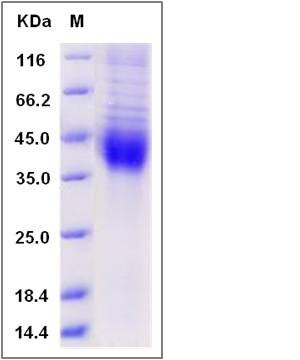Human ASGR2 / ASGPR2 Protein (His Tag)
ASGP-R2,ASGPR2,CLEC4H2,HBXBP,HL-2
- 100ug (NPP1914) Please inquiry
| Catalog Number | P13908-H07H |
|---|---|
| Organism Species | Human |
| Host | Human Cells |
| Synonyms | ASGP-R2,ASGPR2,CLEC4H2,HBXBP,HL-2 |
| Molecular Weight | The recombinant human ASGR2 comprises 252 amino acids and has a predicted molecular mass of 28.9 kDa. The apparent molecular mass of the protein is approximately 37-42 kDa in SDS-PAGE under reducing conditions due to glycosylation. |
| predicted N | His |
| SDS-PAGE |  |
| Purity | > 95 % as determined by SDS-PAGE |
| Protein Construction | A DNA sequence encoding the human ASGR2 (P07307-1) (Gln80-Ala311) was expressed, with an N-terminal polyhistidine tag. |
| Bio-activity | |
| Research Area | Signaling |Signal Transduction |Cytoskeleton / ECM |Cell Adhesion |Lectin |C-tyep lectin | |
| Formulation | Lyophilized from sterile PBS, pH 7.4 1. Normally 5 % - 8 % trehalose, mannitol and 0.01% Tween80 are added as protectants before lyophilization. Specific concentrations are included in the hardcopy of COA. |
| Background | ASGR2 is a subunit of the asialoglycoprotein receptor. Asialoglycoprotein receptor, also known as the Ashwell receptor, which is specific for desialylated (galactosyl-terminal) glycoproteins and is expressed exclusively in hepatic parenchymal cells. This receptor is a transmembrane protein that plays a critical role in serum glycoprotein homeostasis by mediating the endocytosis and lysosomal degradation of glycoproteins with exposed terminal galactose or N-acetylgalactosamine residues. ASGR2 is a glycoprotein. The asialoglycoprotein receptor may facilitate hepatic infection by multiple viruses including hepatitis B, and is also a target for liver-specific drug delivery. The asialoglycoprotein receptor is a hetero-oligomeric protein composed of major and minor subunits, which are encoded by different genes. ASGR2 is the less abundant minor subunit. |
| Reference |
